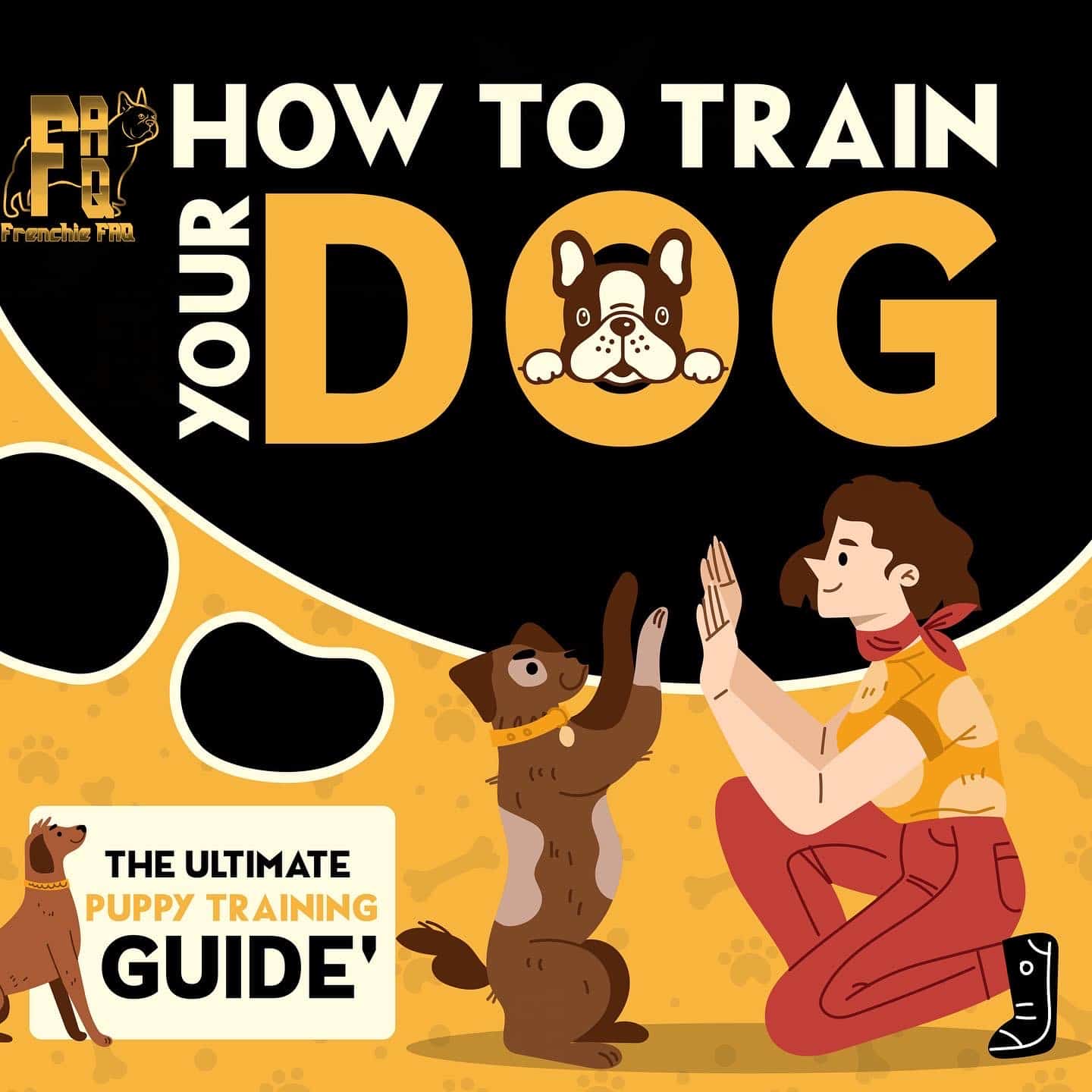
Need help with dog training? The key to a happy relationship with your dog is training them well.
When you train your pup, it develops an unspoken language between you and your pet through words, hand signals, whistles, and other methods.
Some of your dog’s basic needs include socializing and proper training. It’s essential to teach your dog to sit, stay, come, go to their crate, and relieve themselves outside as soon as possible. Training your dog, especially if it’s your first dog, can seem overwhelming. But believe it or not, even a newbie can do it by themselves. This task will seem far less overwhelming if you approach it step-by-step.
Before we move into training steps for your dog. Let’s see what every dog parent’s dream is about having a puppy.
Looking for a French Bulldog puppy? Visit our For Sale page!
The Perfect Puppy Dream and Getting Started to Achieve It
We, as puppy owners, all dreamt about this vision. A puppy that’s leisurely strolling beside us or sitting calmly at our feet while on the patio of our favorite cafe.
But there are some steps you first need to take to ensure your pup is on the right track with their training to get there!
So what is the best method, and how do you use these techniques? We will teach you the most common methods for how to train your dog (as well as what techniques not to use in your dog’s training).
In the beginning, your pup will definitely have some bad habits: nipping, chewing, potty accidents, barking, and more. Therefore, you can not delay the training process. Your puppy is growing and developing quickly and the bad habits will keep getting firm as they age.
Once they’ve been home for a couple of weeks, your puppy should know the basics of a daily routine and be working on obedience training and learning basic commands.
But, you must be thinking, “How do I know when I should begin training my pup?”
No matter what age you bring home your new dog, Worry not.
The rule of thumb for dog training is “the earlier, the better.” You can use our puppy training schedule as a guideline.
It’s essential to remember that every dog is different, and training methods for one dog may not work for another. Be patient and persistent, and most importantly, have fun!
Below we’ll walk you through some dog training with the basic steps that you must take to train your puppy. If it’s a brand new puppy in your home we recommend you read our first night with your puppy guide as a prerequisite.
Crate Training
Potty training should be on your priority list if you recently brought a new puppy home.
What if we tell you there was a technique to make housetraining easier while promoting security and comfort in your dog?
Crate training involves training your dog to spend time in its crate and eventually accept it as it’s place in your house.
Crate training takes advantage of your dog’s innate desire to maintain their sleeping space tidy because they are less likely to relieve themselves in their hangout or sleeping areas.
When you’re not there to oversee your dog, using a crate helps keep them secure and out of trouble. Additionally, it offers a cozy hideaway for your dog to escape when the chaos of the family becomes too much.
Dogs require lots of support from you to gradually get used to spending time in their crates. Rushing the procedure puts your dog at risk for stress and anxiety, which can lead to difficult-to-reverse negative associations with the crate.
Crate Train a Dog: Step by Step
The steps below aren’t meant to be done all in one day. Spend as much time as you need on each step to ensure your dog feels content and stress-free. That’s how you lay the foundation for a lifetime of looking forward to their crate.
Ready to dive into crate training? Here’s how it’s done.
- Introduce the Crate
- Practice Closing the Door
- Step Away Briefly
- Work Up to Longer Stays
If you follow these steps, chances are that before long, your puppy will begin to settle into their crate with ease happily—and that’s a significant life improvement both for them and for you.
Dog Leash Training
Dogs don’t naturally know how to walk with a leash on– they have to be trained. It’s essential for your and your dog’s safety and for those around you.
Since all dogs have a prey drive which can cause them to run away and get lost, leash training a puppy or dog is essential. Despite what you or your pup may want, a dog can’t always run around off-leash.
Leash training a dog takes time and requires a commitment on your part. Take it slow and follow these steps:
- Introducing the leash.
- Practice basic obedience.
- Begin leash training inside.
- Take your puppy outside.
- Keep a firm grip.
- Reward desired behavior.
- Choose a calm location.
If walking is stressful or overwhelming, or even if it isn’t, don’t hesitate to seek support from a trusted dog trainer. Many dog owners who struggle with leash training find they get to a breakthrough with the help of a trainer who can help create a personalized plan to help you and your dog learn to enjoy a lifetime of walking together.
Puppy Socialization: Why, How, and When to Do It Right
Your puppy needs socialization if you want a well-behaved, content, self-assured dog. Make sure your dog is a good citizen by taking the subsequent actions.
Discover below when is the ideal time to socialize a puppy, how to do it properly, and why it matters.
During your puppy’s first three months, they will experience a socialization period that will permanently shape their future personality.
Before you even bring your pet home, the socialization process should begin when you purchase a puppy from a trustworthy breeder. A pleasant, self-assured dog is developed throughout the first few weeks of your puppy’s existence with the breeder’s gentle care.
Puppies may start approaching people who are passively observing them as early as three weeks of age, so having a skilled breeder who promotes a pleasant experience with people — adults and children — will help mold the puppy’s behavior as an adult.
Good breeders give their puppies safe indoor and outdoor habitats, car rides, crates, sounds, and smells to explore as they grow.
Here are the fundamental steps to take:
- Introduce new sights, sounds, and smells to the puppy
- Make it positive.
- Involve the family.
- Take baby steps.
- Take it public.
- Go to puppy classes.
If you have adopted an older dog, chances are it wasn’t socialized as a puppy and may show signs of fear or anxiety around other dogs and people. Since it takes more patience to break old behaviors than to form new ones, socializing with older dogs frequently requires patience. The well-being of your dog can still be improved by continuing this activity.
Remember: Practice makes a dog perfect, and the more successful interactions your dog has with his brethren, the easier it will get.
Choosing an Instructor for Your Dog
Whether you want to schedule private lessons or enroll in obedience classes to address your dog’s behavior issue, picking the best dog trainer can be challenging.
Since dog training is not regulated, anyone can claim to be a dog trainer regardless of training background.
What, then, should you search for? The essential information you should understand before hiring a dog trainer is covered in this article.
After checking the certification, you should consider a few other criteria when selecting a personal trainer.
- Ask for References.
- Talk to the Trainer.
- Working Experience and Area of Specialization.
- Find Out What the Trainer Charges.
- Education.
- Liability Insurance and Business Policies.
- Compatibility.
Most dog trainers won’t advertise openly that they use aversive (i.e., old-fashioned and violent) methods. So we created a cheat sheet to make it easier to spot red flags.
Don’t go ahead with a trainer, if they are using:
- Prong Collars
- Oke Collars
- Electronic Shock Collars, aka, e-Collars
Another essential rule to follow: Never hire a trainer who makes guarantees!
Like us, animals have complex emotions—there’s no “one size fits all” approach.
Training can help you communicate better with your dog, but no trainer can guarantee success. So if you encounter one who overpromises, it’s time to say, “Thanks, but no thanks.”
5 Essential Dog Commands
We all know that teaching our dogs some basic obedience skills can make our lives with them much more accessible. After all, a dog who can walk politely on a leash, come back when you call, and follow other simple instructions is much more fun than an out-of-control canine with no manners!
If you have a new puppy at home that needs training, or even an older dog that you’d like to teach a few things, you may be wondering where exactly you start teaching your dog commands.
While taking a class may benefit you and your pup, there are many dog training commands you can teach your dog right at home. Below, we’ve listed the best dog commands you and your pup can enjoy.
Come, Sit, Down, Stay, and Leave It—these five basic commands can make a huge difference in your relationship with your dog.
We are going to give you a few simple “rules” for training in general and then a primary method for training your dog to respond to each of the five fundamental commands, below:
- “Sit”
This is an essential and easy-to-teach command. Starting with something easy gives a positive boost to the training session for both the dog and you. Teach, sit, and hold a treat by your dog’s nose. Lift your hand and the treat until his head follows your hand. This will naturally cause his butt to lower in a sitting position. After he’s sitting, say “sit” and give him a treat and praise.
Note that: Repetition is key to mastering any command.
- “Come”
This command is a lifesaver. Teaching your dog to respond to your calls the first time, every time is a necessary command—especially if he slips out of his leash or out the door without his leash.
Teach your dog this command in the house by having someone hold him in one room while you either go to the end of the room or another room entirely. Call him with the come command. Infuse enthusiasm into your voice and reward your dog with a treat and praise when he comes on command. If you are ecstatic to see him—petting and making a fuss over him every time he comes to you—he will have no reason not to come when called.
- “Leave It”
This command is necessary if you need your dog to leave something it has picked up off the floor that she shouldn’t eat or if you want her to stop chewing on your shoe, a piece of food, or a toy.
Leave it is a variation on give it. You can use the same idea (drop, give, or leave) as long as you use the same command, so your dog doesn’t get confused. Know what action you’d like your dog to perform, then reward her for doing it.
- “Down”
This is important for your dog to learn because it can keep her from jumping on guests, getting on the counter and putting her face on the dinner table.
To train this, get your dog into a seat and then coax him to the down position by moving your hand with a treat toward the ground. He will follow your hand and will get into the down position.
Once he has learned this, you can move on to other things, like teaching him the trick of rolling over.
- “Stay”
When your dog has mastered the sit and down, you will want them to learn to stay. Get them into a sit or down position, hold your hand up, palm forward and say “stay” while slowly moving away from them. If it moves out of the sit or down position, come back toward him and start over.
Offer a treat or praise when it remains in a stay position, even if you only move two feet away from him. Once he stays, increase the length of time you keep him in stay, then use the come command. Reward with lavish praise and treats.
You will eventually be able to work up to a stay command where you can move out of the eyesight of your dog, and he will wait for the coming command.
Potty Training Your Dog
Potty training is an important part of caring for your dog; whether you’re getting a puppy or an adult dog, you need to know how to house-train them properly.
With a plan, patience, and observation, you can set your puppy up for success so that they know exactly where they should pee and poop and, in the meantime, develop a healthy sense of boundaries in your house.
Take them out when they wake up, after every meal, at playtime, in the bed, before you leave them when you come back, and then every 45 minutes.
Signs that your dog needs to go to the toilet include:
- Fidgeting,
- Sniffing around,
- Beginning to circle before squatting.
When you recognize the signs that your dog is thinking about toileting, here’s what you should do:
- Take them to the correct place so that you can reward them when they go. Try to take them to the same place each time.
- When they begin to potty, use a verbal cue they can associate with the correct behavior, e.g., ‘toilet’ or ‘potty.’
- When they’ve finished, reward them immediately, every time, with lots of praise and play!
Before going back inside, walk your dog around or play for a bit. This way, they don’t learn that going to the toilet ends time outside, which could mean they hold onto the last minute before going.
If you notice your dog about to go in the wrong place, interrupt them in a way that doesn’t punish them, e.g., calling their name. When they relieve themselves in the proper location, gently lead them there and shower them with praise. Don’t yell. If not, your dog can discover that it’s only safe to use the toilet when you’re not present.
Take your dog outside frequently, praise them profusely when they relieve themselves, and eventually, they’ll ask to go out.
Dog Training Schedule by Age
Now that we have covered these essential topics, it’s time to create your puppy’s training schedule. You can utilize the basic puppy training timetable given below, which begins at two months old (8 weeks) as your puppy matures.
You can begin training your puppy as young as 8 weeks, gradually increasing the difficulty and duration of training sessions. Most training will happen up until your dog is 1 year old. However, training exercises can continue at their own pace throughout their lifetime.
It’s important to remember that Every puppy is different, even within the same breed or litter. Thus, some may require more time at particular phases, while others can proceed to more advanced training more quickly.
The main thing to remember with training is you go at your puppy’s speed. Don’t rush them if they’re not ready yet to move on to the next!
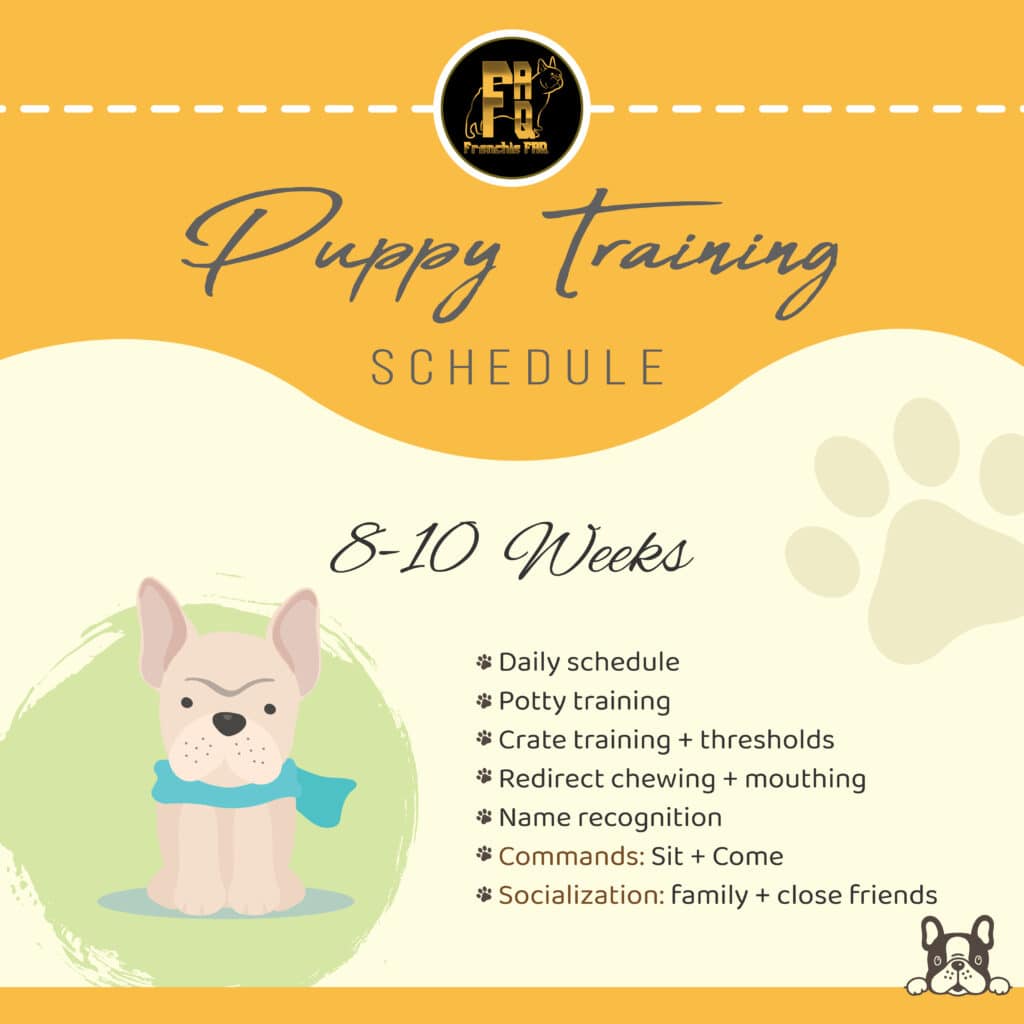
8-10 Weeks Old
Your dog should learn the fundamentals at this stage of their development, including their name, appropriate behavior at home, the beginnings of some commands, and some early socialization.
Get your puppy used to a routine that includes the following activities each day:
- Potty training
- Crate training
- Introduce basic obedience commands
- Start socialization
- Name recognition
- Start to redirect chewing and mouthing behaviors
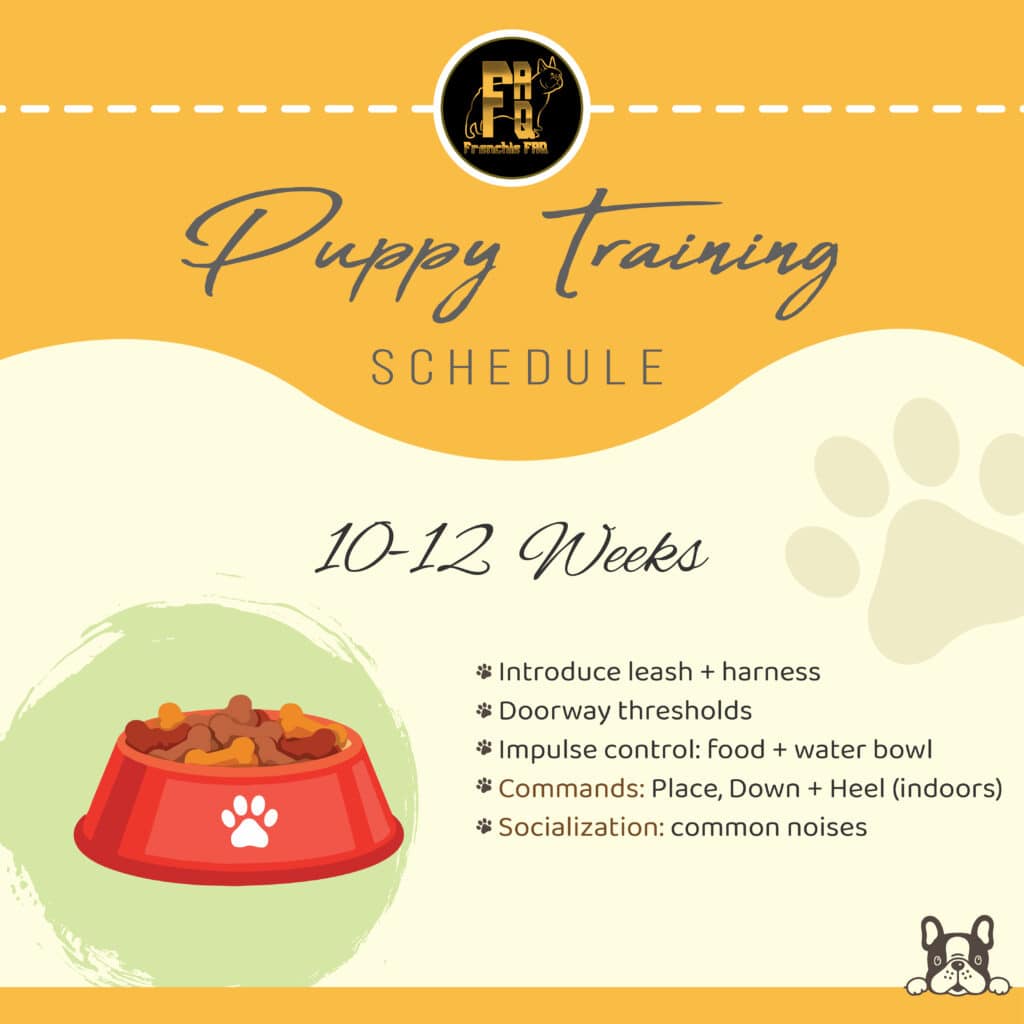
10-12 Weeks Old
You will now start to develop your dog’s obedience training, socializing skills, and self-control.
- more fundamental obedience commands
- Continue socialization
- Impulse control practice
- Start threshold training

3-4 Months Old
Your dog is quickly developing, so you can help the process with more challenging training routines with the commands. They’ve learned!
- Introduce Stay and Leave-It
- Start command combinations
- Practice Heel
- Begin to socialize
- Introduce structured play sessions
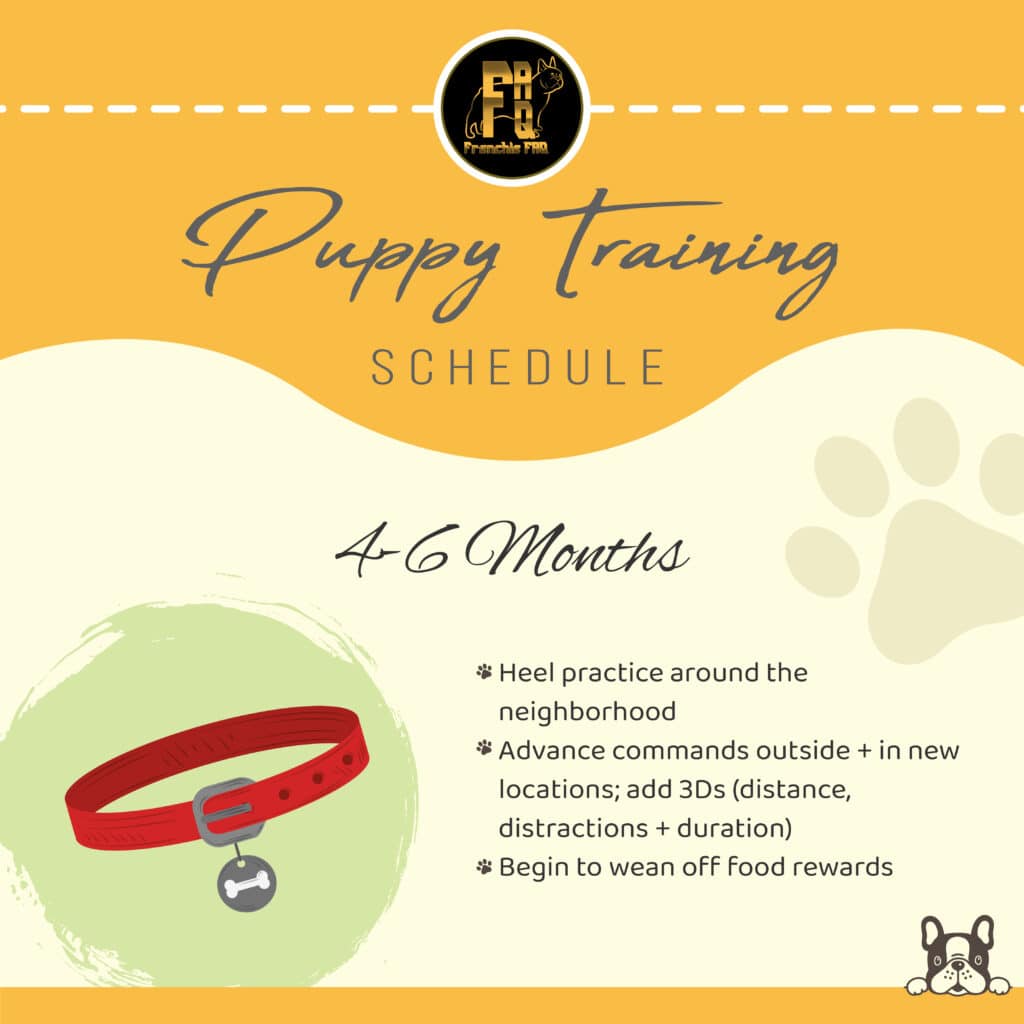
4-6 Months Old
Your dog should now start practicing their commands outside of your home and in public areas and should keep up their socialization!
- Advance on their commands
- Extend your walks with your puppy
- Begin weaning your puppy from food rewards.
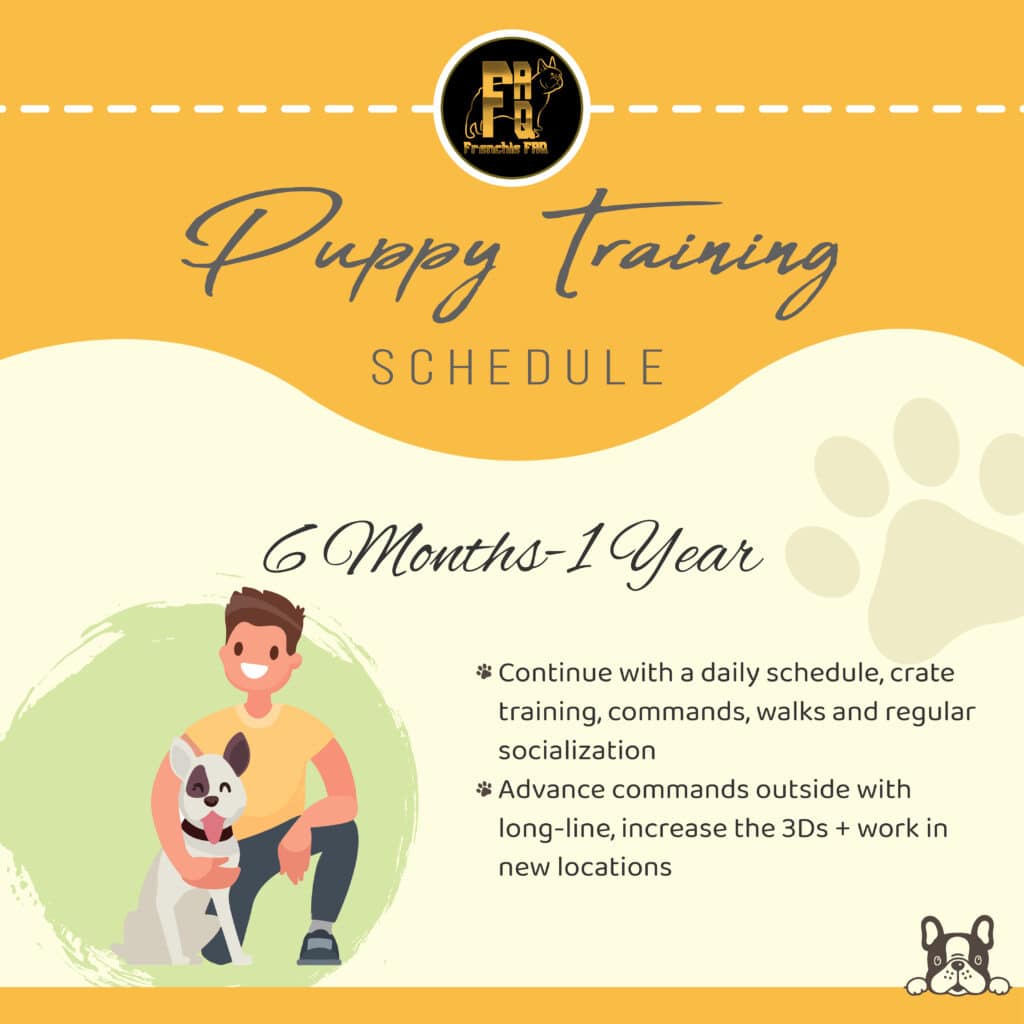
6 Months – 1 Year Old
Your puppy should be well-versed in all basic commands and have a strong foundation in socializing, crate, and potty training. You will now work with your puppy to reinforce what they have learned moving forward.
- All the commands should be repeated.
- Maintain structure at home
We’re often asked what the most important thing is to know about raising a dog, and our answer is always the same: Start training early!
Expert Dog Training
When your dog has learned the fundamentals, you should teach him more advanced tricks. These activities keep your dog healthy, active and psychologically engaged. Additionally, they will contribute to developing your relationship with your dog.
Keep in mind that training is a continuous process. You will always have work to do. Throughout your dog’s lifetime, obedience training must be continued.
People who pick up a language early on but stop using it may lose a lot of it as they age. Your dog is the same way—use it or lose it. Even the simplest tricks and commands can benefit from repetition to stay fresh in your dog’s memory. It’s also a fantastic way to spend time with your dog.
Last Words:
Hopefully, you are now clear about the basic steps you need to take to train your dog for different dog training. One thing that you need to keep in mind is dog training is a never-ending process of evolving. 5 minutes a day Monday through Friday is better than 30 minutes on Saturday.
Good luck, fellow dog owners!